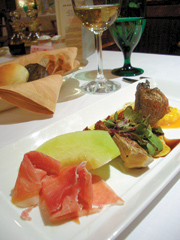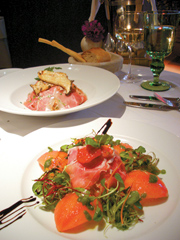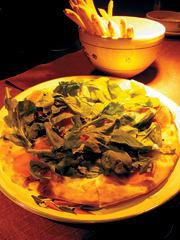Italian prosciutto lands on the shores of Korea

Prosciutto di Parma with melon and grilled scallops at La Stella.
More recently, Italian prosciutto, or cured ham, has begun finding its way onto the tables of Korean epicures, and appreciation for the real thing is ever so slowly changing the country’s perspective on cured meats.
Well-heeled and traveled Koreans sip wine and dine in Italian restaurants, contributing to the evolution of the local dining scene. Yet the most fervent advocates of Italian cuisine are none other than a handful of Italian expatriates living and working in Korea. To them authenticity is a cult religion.
Because importers have recently begun taking advantage of a 2004 regulation that allows the importation of pork “cured more than 400 days,” Italians can at last savor prosciutto in Korea. In Italy’s northeastern region, a home of prosciutto for more than 2,000 years, there are hundreds of varieties.
While prosciutto ― the monarch of Italian cured meats ― has recently become available, it is one of only a handful of Italian meats that made the cut. Salame, for example, is banned.
Antonio Patella, owner of Antonio and one of a few Italian restaurateurs in Seoul, reacts wildly when asked about the import regulations for salumi, a word meaning all cured meats.
“Because the Korean regulation bans importation, we have absolutely no salame in Korea,” he said. “Can you imagine every Italian pizza sold in Korea has no Italian salame? All salame sold here comes from America or Australia.”
The level of passion could be compared to an angry Korean master who cannot make his kimchi without Korean peppers.
Mr. Patella, a native of Puglia in Italy’s southeast, is fastidious with ingredients and said, “Many restaurants use jamon but jamon, ham from Spain, and prosciutto, ham from Italy, look different and taste different.”

Prosciutto di San Daniele with artichokes and buffalo mozzarella cheese with basil sauce, foreground, and with mushroom risotto at Vecchia e Nuovo. By Ines Cho
The next day, I looked up Maurizio Ceccato, who maintains an excellent reputation among Italian expatriates. His restaurant, La Stella, inside the Holiday Inn hotel in northern Seoul, looks outdated, but his hands remain extremely fresh and agile. The cook from Veneto proved that by bringing to the table two top-quality starters: Parma ham with fresh melon and grilled artichokes and scallops (12,000 won each, plus 10 percent VAT and 10 percent service charge).
To savor prosciutto’s subtle flavors, he suggested a dry but not-too-aromatic white wine, such as Pinot Grigio or Prosecco. Of course, a bottle of Chardonnay and Pinot Grigio called 2002 Le Rime (70,000 won) went down like syrup.
While I thought I might go home wrapped in Parma ham, the chef said La Stella didn’t have any main dishes made with prosciutto. But Mr. Ceccato’s amazingly fresh black ink pasta, ravioli and risotto erased the thought completely.
The final stop on my prosciutto tour was the Vecchia e Nuovo restaurant inside the Westin Chosun Hotel. Federico Rossi is whipping up special prosciutto dishes. The San Daniele Promotion, which runs until March 31, is the first of its kind in Korea and features prosciutto di San Daniele. Mr. Rossi uses cured ham from San Daniele in the northwestern region of Friuli Venezia-Giulia, another region famous for prosciutto, because “Koreans don’t like salty ham.”
Prosciutto cured in Parma and San Daniele differs in appearance and taste. Compared with Parma, prosciutto di San Daniele is darker and sweeter because of the climate and the pig’s diet. Mr. Rossi, a native of Verona, showed us the truly creative potential of prosciutto di San Daniele. In his kitchen, slices of prosciutto were transformed into a pouchette that hid delicious mysteries inside. Aided by a bottle of Pinot Griogio, 2003 Danzante (70,000 won), my job in uncovering the mysteries was as easy and smooth as a Bond girl’s.

Pizza with prosciutto di Parma at Antonio
La Stella
English: On the menu, spoken
Tel: (02) 710-7277
Web: www.holiday-inn.co.kr
Hours: Open daily, 6:30 to 10 a.m.; 11:30 a.m. to 3 p.m.; 5:30 to 10 p.m.
Location: On the first floor of the Holiday Inn Hotel in Mapo district
Dress: Smart casual or business
Parking: Nearby
Antonio
English: On the menu, spoken
Tel: (02) 3443-4333
Web: www.antonios.co.kr
Hours: For meals, 12 to 2:30 p.m., 6 to 10:30 p.m.; for coffee and wine, open all day and until late.
Location: Behind the Audi store in Cheongdam-dong
Dress code: Smart casual or elegant
Parking: Valet
Vecchia e Nuovo
English: On the menu, spoken
Tel: (02) 317-0033
Web: www.echosunhotel.com
Hours: Open daily, 11:30 a.m. to 3 p.m.; 5:30 to 10 p.m.
Location: In the basement of the Westin Chosun Hotel in central Seoul
Dress code: Smart casual or business
Parking: Available
By Ines cho Staff Writer [inescho@joongang.co.kr]










with the Korea JoongAng Daily
To write comments, please log in to one of the accounts.
Standards Board Policy (0/250자)